![]()
![]()
![]()
Use LEFT and RIGHT arrow keys to navigate between flashcards;
Use UP and DOWN arrow keys to flip the card;
H to show hint;
A reads text to speech;
49 Cards in this Set
- Front
- Back
- 3rd side (hint)
|
Machi geri 町 |
S: Tai / hiraki.
A: any punch. D: yoko muso gamae (back fist over fist) and kick jun geri This is seriously simple |
|
|
|
Dan geri sambo uke dan geri gaeshi
|
Tai Gamae.
Attack: jun dan geri low then high
Martin's does a leg block for the first, followed by a triple block for the second. Sensei Mike UTS 2016 said both timings are acceptable. Sensei Rob's 2022. hiza leg block for the first of the attacker kicks. Then kick back while having juji uke in place. Return to be in triple block stance for the second kick. After which kick back and ren han ko. |
Kakuritsu Ken
|
|
|
Sokuto geri hiki ashi nami gaeshi
|
Stance: Tai / hiraki.
Attack: gedan jun sokuto geri (to fushi or knee) Defence: step off and kick the back Wsko draw back the leading foot and sokuto at the same time as the attack. |
Once upon a time while in the woods. A straight kick came in and bit a chuck from the thai. Kakuritsu Ken Being little seems to help Sensei Mike UTS 2016 suggested I could kick the other leg if not the back which kick Aled's bottom. |
|
|
Mikazuki gaeshi kari ashi
|
S: Tai gamae
A: sashi kae jun zuki. D: Taki gamae, bring A jun zuki arm down to make space, gyagku fri zuki to Mikazuki, thump back of the head and then stab kick back of leg. On Dan you have to step forward into position. On Mitsouko fine. |
In a Tall woods they step through to show Mikazuki and returned with Tai-ki stance WSKO White Book Byakuren Ken kari = moving forward |
|
|
Suigetsu gaeshi oshi taoshi
|
S: Ta gamae.
A: gyaku zuki. D: Taki gamae, Classic start. Non-defending hand hit Suigetsu using fri suki. Then using same hand attack tenchu back of the head. Finally body slam to push the opponent away. [Be convinced that a solid strike will bring the opponent down]. |
In tall woods show Suigetsu from tai ki stance WSKO White Book Black Belt course 2015On Mitsouko fine. oshi taoshi = in akido front down push |
|
|
Hangetsu gaeshi sukui kubi nage
|
S: Tai.
A: Jodan jun zuki followed by chudan gyaku zuki. D: Midare Gamme. Block the first attack (Oishi). 'Decicive' Kumade suki (bear claw). hiza geri. Flowing with the same bear claw hand open to dai wanto the back of the attackers head so that you force them to roll out down to the ground (sukui kubi nage). |
Black Belt course 2015 ? -try again where you can roll kubi=首=neck hiza=ひざ=knee Sage hiji ate= 下肘当 = Hiji ate downwards mainly to the back when opponent’s head is around your waist 掬受=Sukui uke=Scoop up block, scoop opponent’s Mawashi geri with Tai sabaki (open hand) |
|
|
Chudan gaeshi
|
Hiraki.
Attack: jun mawashi. Defence: taiki gamae but really exaggerated (open); gyaku shita uke and kick back. |
In a moonlight forest show chudan target from tai kai stance Sango Ken |
|
|
Fukko chi ni |
Seiza. A: jun mawashi, gyaku zuki. D: block kori
From sitting on your knees. Step up in Fukuo Gammae on side being attacked. leave head back to be dodge and block then punch.
|
Facing bin Stuart Attacks
Means crouching tiger
floor =chi
2
WSKO White Book Chio Ken
Nailed at grading 2016 |
|
|
Soto uke dan zuki (ura & omote) |
Tai (ura), Attack: straight punch Defence: tate muso gamae. Block Soto and punch to the head. |
In a tall moonlit forest standing tall like you are waiting at the bar Nio Ken WSKO White Book pg 120 Slight name and stance changes probably for obvious reasons |
|
|
Uchi age dan zuki (ura & omote) |
Tai (ura), hiraki (omote). Attack : straight punch Defence: front hand cover uchi age (over head) and punch back
|
Messed up stance on grading 2016 |
|
|
Shita uke dan zuki |
Tai gamae. Attack Shita uke attack Defence : hasso game. Shita uke (block). ura ken tsuki komi to jinchu or nichigetsu |
Ura ken = 裏拳 Wsko= Hiraki? Shita uke block and meuchi with leading hand and counter strike. |
|
|
Harai uke dan zuki |
Hiraki. Attack. Kick moshi geri Defence: Block Harai Uke. Step to do ura ken tsuki komi (hitting the third eye) or ura ken uchi to sango (temple). Use the back of the fist to punch, there is no bounce of wrist in classical Hokei. |
Facing the house. Stuart attacks. WSKO White Book Byakuren Ken Ura ken = 裏拳 |
|
|
Uwa uke zuki with nioi |
Tai. Attack. Overhead knife stab Deference : Uwa uke zuki "Omote (sashi kae ashi)" |
Goka Ken. Ura ken = 裏拳 |
|
|
Age nuki
|
Stance: seiza or hiraki Attack : grab the same side (left/left) wrist & push to thigh or chest. Defence : Raise fingers (squid) and fast turn of hand. |
age do do do sitting in the night forest age do do do |
|
|
Idori okuri gote, okuri yoko tembin, ura gatame
|
D: seize kusushi fukko gamae
Raise a back knee (same side as attack) and get some distance, keep kagete super close and perform okuri across the belt. When Mitsouko falls. Do a classic starter pin. |
Wsko White Book. Ryuka Ken. On Mitsouko this is hard and what is kusushi of fukko gamae ? |
|
|
Idori gyaku gote, osae yubi gatame |
Stance: defender seize Attacker : gyaku gote Defender: kusushi fukko gamae. Pop up the same side as you get pulled. Stay seated throughout. osae yubi gatame involves the wrap pin with elbow and wrist. Keep your head away from punch and apply pressure on the the wrist |
Wsko White Book. Ryuka Ken. yubi=finger=指 |
|
|
Idori oshi gote, kannuki gatame |
D: seize kusushi fukko gamae This the only one you should stand up for. Cyprus 2022 |
Wsko White Book. Ryuka Ken. |
|
|
Katate nage
|
The George classic
S: Tai A: shikaka waza D: Step across like ude juji. This needs to be high (M) across the attaker chest hight. Duck underneath with your back to the attacker. Place the back foot behind theirs (M). Focus on the correct distance. Slightly adjust the attacker arm into position. You should be elbow to elbow. Kneel in front of attacker far leg then twist body round till they drop. kannunki gatame Remember to Keep close. Mayfair Stuart T - Feb 2016 On Will stand to make him fall. The alternative is a hip push maki shape against the chest. Step behind the attacker and focus on stretching the figures. S. Rob and Danny talk about following round so you spin on your knees 180. |
Black Belt Course 2014 In WSKO White Book. Goka Ken. 二足全転換 = Nisoku zen tankan = Zen ten kan in 2 steps (in Katate nage, Se nage) |
|
|
Gyaku katate nage |
tai/hiraki attack gyaku gote
did with john - hard try again....
Katata nage as someone attacks gyaku gote Stretch back of the hand and then into Katate Nage |
? Goka Ken.
|
|
|
Okuri katate nage
|
(Goka Ken) Attack: Yori Nuki Defence: Do Katate nage. |
In WSKO White Book. Goka Ken.
|
|
|
Gassho katate nage
|
handshake. Katate nage
|
|
|
|
Ryote katate nage
|
Tai. A: ryote grab Like Katate nage but go instead the attacking hands.
|
|
|
|
Morote katate nage
|
Tai / hiraki. A: attempt ippon se nage or gyaku tembin Like Katate nage |
Face the garden. In WSKO White Book. Goka Ken. |
|
|
Sode maki gaeshi |
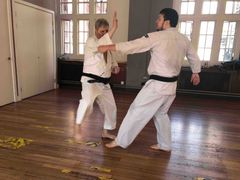
S: Tai. A: grab sleeve lower sleeve and ashi barai (sweep the leg). And punch.
D: aiki gamae (front hasso back hand up). (Wsko open front hand offer back hand ) On embu. For Micheal he plants his foot and you take the balance. Yasue says normal pin.
Wsko wrap with a naga and pin is new
Ben says use elbow
(Sode Maki is arm grab maddona cut with a yori nuki) |
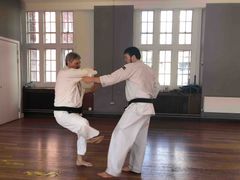
In WSKO White Book. Rakan Ken 足払い ashi barai |
|
|
Sode guchi dori
|
S: Hiraki.
A: grab sleeve opening, fingers inside. D: [aiki gamae]. Hold hand in place with a wrist grab, then use attacked arm to wrap over the attacker. Feel when it is right. Take down. Black Belt Course 2015 |
Messed up on grading |
|
|
Sode guchi maki |
Stance: Hiraki. Attack: grab sleeve opening, thumb inside. Defence: aiki gamae.
|
Black Belt Course 2015 |
|
|
Kiri kaeshi gote
|
Kiri Gote where the attacker releases Hiraki. A: Normal attack but as the technique is applied release the grip. D: Start the Kiri Gote so you are in front of their centre line. As they hold attacker "Boshikyū to Boshikyū" and lock attacker elbow by pushing it up and the drop attacker behind by applying pressure to the hand. Yasuae Sensei UTS 2016 |
Anyone grabbing your kir royal are at the house. To gote them you need to hold their palms. Wsko White Book. Ryuka Ken Boshikyū = 母指球 = palm |
|
|
Kiri kaeshi nage |
Kiri Gote where the attacker pushes through Hiraki. A: Attack kiri gote and push through D: 'Swoosh back', go in gassho and then swing under the arm to throw over your own shoulder. There is to distinct steps here.Two pins on gassho arm. Yasuae Sensei UTS 2016 |
Wsko White Book. Ryuka Ken
|
|
|
Morote Kiri kaeshi nage |
as kiris kaeshi nage. You can do this on Stuart.
Yasuae Sensei UTS 2016
Start morose Kiri gote. When slight bent over pull down. Think about the guiding finger pointing to the floor. Step back (don't pivot) |
|
|
|
Uwa uke se nage |
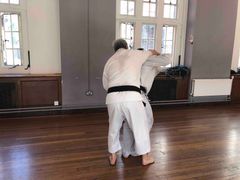
Tai. A: ura ken tsuki komi or shuto uchi. D: block, jun zuki. grab bi-cep. back to the opponent and crash the centre line. bottom to groin. Throw Iponse nage.
S. gee places supporting leg behind. Aled:from judo. Can do Sergey and Kunut.
aled suggest doing a step to take down. |

背 = Se = Naga 手刀打 = Shuto uchi = Kaishu uchi with the edge on little finger side. First time you see it after the beginners. |
|
|
Furi sute omote nage |

Earliest stage of response to ippon se nage
S: Hiraki. A: ippon se nage. D: manji gamae Outside Kagite. Huge step to follow the attacker. Sweep down to the floor with mirror face showing.
The attacker has one hand and is on one foot as the technique starts.
|
ふり (Furi) could mean make-believe Pretense simulation pretend.
Sute is name - forsaken foundling.
Martin's least favourite.
Misuno Sensei UTS 2016 In WSKO White Book. Ryuka Ken.
|
|
|
Morote okuri gote nage |
Second stage of response to ippon se nage
S: Hiraki. A: ippon se nage. D: [manji gamae]
The attacker has two hand and is on one foot as the technique starts. Sweep up similary to uchi and then sweep to floor.
|
Second stage of response to ippon se nage Misuno Sensei UTS 2016 |
|
|
Okuri tsuki taoshi |

third stage of response to ippon se nage
S: Hiraki.
A: ippon se nage. D: manji gamae, Outside Kagite but it locks. Push into the opponent or across shoulder like oshi gote. Attacker falls arse.
|
In WSKO White Book. Ryuka Ken.
Check if this is the diamond from Sensei Rob. Can use two hands. |
|
|
Koshi kujiki |
slowest stage of response to ippon se nage
S: Hiraki.
A: ippon se nage. D: Like Furi sute omote nage or Okuri tsuki taoshi, but you end up behind. Strike the buttock above the thai and do the hip hop move to release. Almost back on you.
Misuno Sensei UTS 2016
|
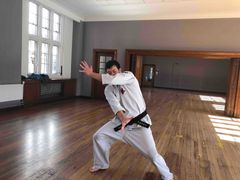
In WSKO White Book. Ryuka Ken. 腰=hip or waist =Koshi |
|
|
Konoha okuri, konoha gatame |
Hiraki. A: shikake waza bend back fingers (use less fingers that the boys) lock wrist bend arm towards the movement you want to achieve walk the defender practice making this work doing down
Leaves of a tree = kohona |
In WSKO White Book. Ryuka Ken. |
|
|
Konoha gaeshi
|
Hiraki.
shikake waza. front hand softly grab their front fingers. Take off balance to A point having the arm in a dori shape. Keep the pin as you spin the opponent. Use your free hand to direct a throw away so they ukemi (no pin) Martin: (no index finger across back of knuckles). Aled too tall to grab with second hand Oct 15 How do you make this graceful ? |
In WSKO White Book. Ryuka Ken.
|
|
|
Okuri yubi gaeshi |
Stance Hiraki. Attacker: attempts konoha attack
Defence : As attacker grabs the finger turn your palm upwards and grab their thumb. Do okuri gote with the thumb locked. |
|
|
|
Okuri shishi dori |
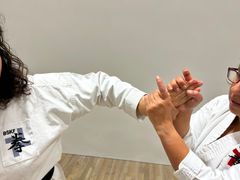
Hiraki. As for okuri gote. Attacker releases their grip
Hold and lock their wrist. With the other hand hold the fingers. Get a shape on the attacker hand. Focus on the joint between the wrist and the arm. Get an s shape on the arm as well. Keep pushing towards the centre point. Moving the lock lower as the defender readjusts their stance. |
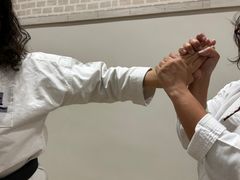
|
|
|
Gassho okuri dori |
S: Hiraki. D: As for okuri gote. A: turn away under to get out of the lock
Block the attackers head against your thigh. Grab attackers hand with both hand and lock above the spine. Shishi Dori the fingers.
|
Learn again.
|
|
|
Nigiri gaeshi |
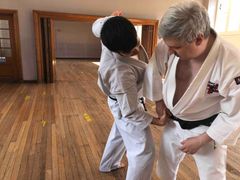
Stance : Tai Attacker: handshake, squeeze. Defence: "ura gassho g." Surprise defence. Reverse dori on the wrist. Keep it low or close (michel). apply gyaka gote.
Nigeria shape of making sushi by squeezing rice |
|
|
|
On Sen (Initiative) |
use hejishin and zanshin to read a situation, apply gi and jutsu with appropriate timing.
Tai no sen “mutual sen” an opponent attacks you deliver a counter attack which lands simultaneously. Opponent’s Inability to defend while fully focused on attacking. Go no sen, “waiting sen” or machino sen. , refers to the initiative whereby an opponent attacks you and is allowed to fully complete her attack before you deliver a counter-attack. Once the attack has been made safe with appropriate evasion and blocks, the counter-attack exploits the emptiness (kyo) in the opponent once she realise sher attack has failed. Sen no sen sense an opponent preparing to attack,wait until he has begun and then immediately are ready to deliver a successful counter-attack. Ki No Sen mihatsu no sen, read an opponent on a psychological level and thus initiate our defence before any attack has actually begun. |
|
|
|
Ma'ai and Opportunity for Offence and Defence
|
Ma’ai the distance between yourself and your opponent. closeddistance (chikama), neutraldistance (kihon ma’ai) fardistance (toma). |
|
|
|
The history and meaning of the Manji |
Indian mark that means... auspicious starts The root of life flowing universe harmony Displayed on Dojo wall and Dogi Tate Manji has circle of shields signifying friends protection |
|
|
|
勘 |
perception,intuition,the sixth sense ken / kan translated, “seeing” and “feeling.” http://www.kiyojuteryu.com/articles.php?pageid=36&ep=1&contentCategory=articles https://classicbudoka.wordpress.com/2011/11/04/38-ken-and-kan-seeing-and-feeling/ |
|
|
|
On Innen |
Important concepts of Buddhism.
refers to cause and effect in every life event the past, the present and the future A combination of two words, in and en. In refers to the direct cause of an effect en refers to indirect causes |
|
|
|
On Dharma
|
No single word translation for dharma in west. Hinduism, behaviours that makes life and universe possible includes duties, rights, laws, conduct, virtues and ‘‘right way of living’’. Buddhism "cosmic law and order" Sanskrit noun dharma is a derivation from the root dhṛ, which has a meaning of "to hold, maintain, keep". |
|
|
|
On Kongo Zen |
Named from the Kings that guard the temple or the Indian hammer (or diamonds) Harmony. Pairs. In-n-en. Ying Yang. Ken Zen. Zen comes from Dhyana (mediation in hindi) Aim. 1. Well disciplined self 2. Peace 3. Paradise in life time Teachings 1. Dharma 2. Shakuson through teaching 3. jiko kakuritsu and jita kyoraku the path (capable of change) |
|
|
|
The meaning and purpose of the Dokun |
Foundations of change.
Words for you. Dōkun [道訓] (teaching of the way) Seiku Meditation 聖句 Seigan Oath誓願 Shinjo Creed 信条 In Japanese Dōin also reads Raihaishi called Kyōten [教典]. Seiku This text is from the Dhammapada (verses 160 & 165), which is one of the central texts in Zen Buddhism. Seiku explains the importance of examining the self, to striving to discover the possibilities within the self, and of aiming to cultivate the self. Seigan expresses the mental attitudes to be applied in pursuing Shorinji Kempo, and the conviction to apply to the training. It explains the sort of resolve with which to strive when learning Shorinji Kempo. Dōkun explain how the human should act. It expresses in a concrete way what actions we as humans should do. [Concrete details for actions (living basics for kenshi).](This part is not translated in the English Shorinji Kempo Tokuhon [only in the Kongo Zen Tokuhon] and because of this not read that often in dōjō outside of Japan. About ShinjōWe reflect on the state of our own hearts and actions. and we renew our determination to put Shorinji Kempo into practice in our daily lives. [Outline of actual practice (norm for action).] |
French Sound for Meditation Pledging an Oath at Gun Point Christian Jo-y at the knowing Jesus. |
|
|
Kumi Embu |
Kusshin geri tenkai ren geri Mikazuki gaeshi kari ashi Moroto kiri kaeshi nage Ryote Katate nage, kannuki gatame Keri Ten ichi sukui kubi nage Sode Maki gaeshi kannuki gatame (offence grab side, ashi barai) Chudan gaeshi ren han ko to katate nage Harai uke dan suki ren han ko to uwa uke se nage |
転回足=Tenkai ashi=Turning steps
|

